Eggs Benedict with Easy Hollandaise Sauce

Eggs Benedict is one of those items that you’ll always see on a breakfast or brunch menu. It’s a breakfast classic. But, when prepared with the traditional ingredients, it can be hard on your waistline, heart, brain and digestion.
In my eggs Benedict recipe, I use immune-boosting, heart healthy, anti-inflammatory foods like avocado, asparagus and tomato. This low-carb breakfast is also high in healthy fats that are key for maintaining optimal health.
So give this eggs Benedict recipe a try — you’ll never go back to the traditional dish again.
What Is Eggs Benedict?
Eggs Benedict is a classic breakfast dish that usually includes an English muffin, poached eggs, Canadian bacon or ham and hollandaise sauce that’s made with egg yolks, butter and lemon juice. Despite the name, the earliest version of the classic recipe goes back to Delmonico’s Restaurant in Lower Manhattan, so it’s an American creation.
When these ingredients are layered and topped with the buttery hollandaise sauce, it serves as a decadent combination, but it can leave you feeling bloated and tired. That’s because of the refined carbs and processed meat that’s included in the traditional eggs Benedict recipe.
To make this a healthier choice for breakfast or brunch, I brought in some nutritious and beneficial ingredients that will boost your energy levels and even improve your heart and brain health. Now you can enjoy this classic dish without the guilt or consequences!
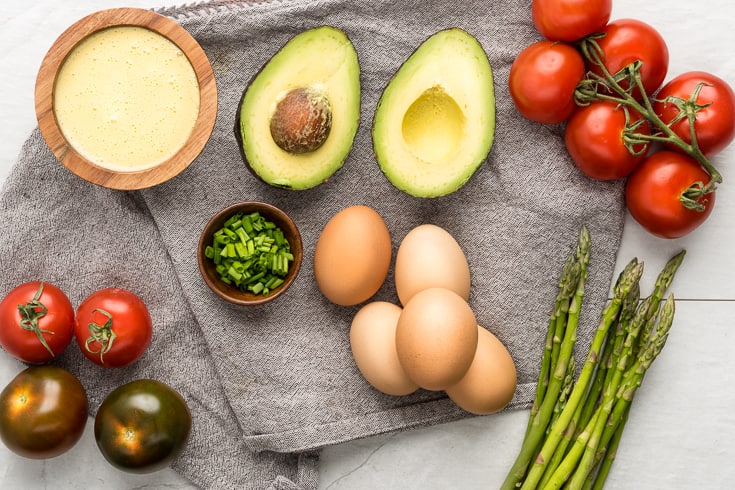
Best Ingredients
Here’s a quick glance at some of the top health benefits associated with the ingredients in my eggs Benedict recipe:
- Asparagus: Asparagus is full of nutrients, including folic acid, potassium, vitamin B6, vitamin A and vitamin C. It’s also very low in calories and has powerful antioxidant and anti-inflammatory properties.
- Avocado: Avocados are one of the best superfoods to add to your diet. They are packed with essential nutrients, including monounsaturated fats that help to reverse insulin resistance and regulate blood sugar levels. (Try our avocado toast recipe for another spectacular brunch item.)
- Tomato: Tomato nutrition is well researched because of its powerful antioxidants. It’s a high-antioxidant food that is one of the best sources of lycopene, an important phytonutrient.
- Eggs: Eggs have a complete amino acid profile, which means that they are a high-quality source of protein. The health benefits of eggs even include weight loss, which is due to the lutein in eggs.
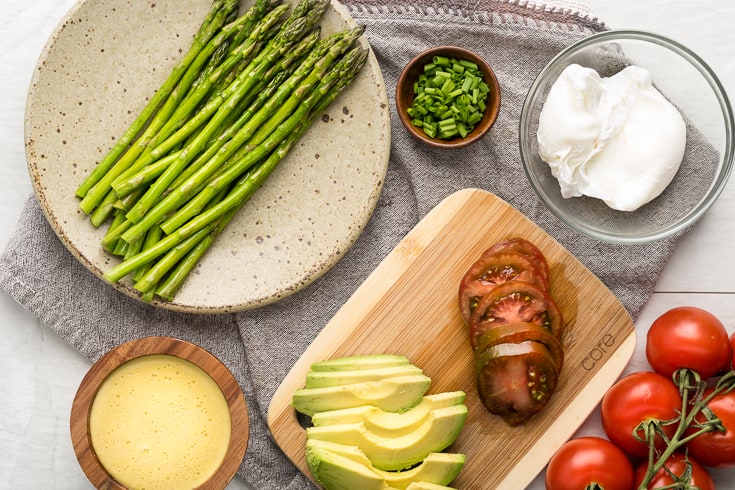
How to Make Eggs Benedict
The first step to making this healthy eggs Benedict is to make the Hollandaise sauce. Our version is full of healthy fats and a cinch to make.
Start by melting the butter or ghee in a small saucepan over medium-low heat. Then add the melted butter, egg yolks, Dijon mustard, lemon juice, sea salt and water into a high-powered blender. Blend it all up until the hollandaise sauce is well combined.
Next, cook up the asparagus. In a medium-size frying pan, add 1–2 teaspoons of either coconut oil or avocado oil and set your stove to medium heat.
Add 1 bunch of asparagus to the frying pan and let them cook until they’re tender. It should take about 8–10 minutes.
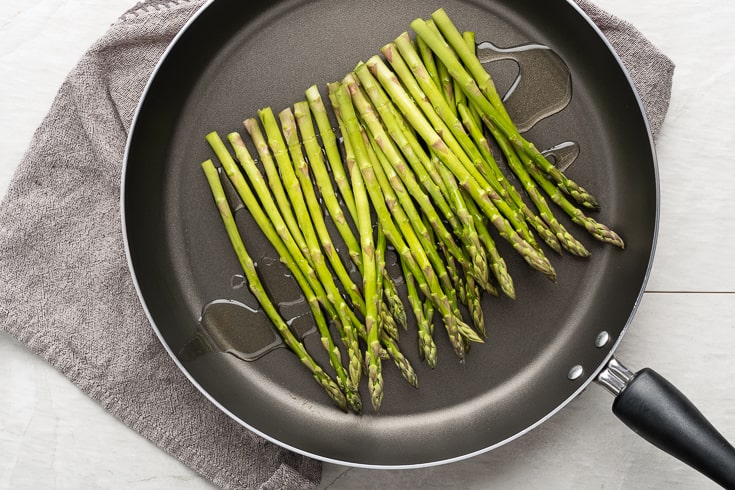
Next, you have to cook your eggs.
To poach an egg, bring 2–3 cups of water to a boil in a small pot. When the water is boiling, gently lower the eggs into the water and allow them to boil for 3 minutes. Then remove the eggs and set them aside so that you can begin assembling your eggs Benedict.
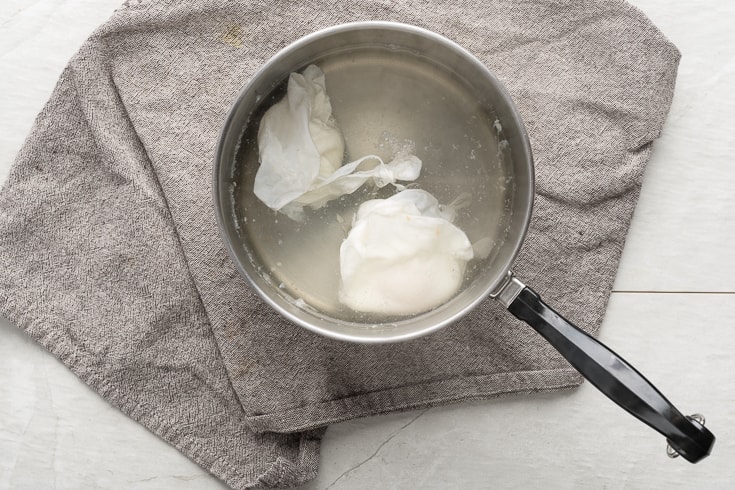
Divide the asparagus on two separate plates. Then slice ¼ tomato and add about 3 slices to each plate, right on top of the asparagus.
Optionally, you can use a big slice of sourdough or Ezekiel bread as the bottom layer, so you’d toast and place that on the plate first.
Now slice ½ avocado and add the slices to each plate, on top of the tomato.
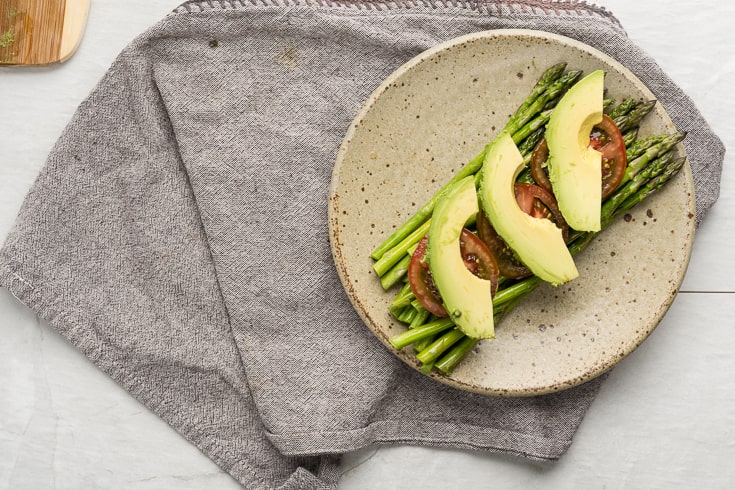
You’e ready to add the eggs on top. When you cut into them, the yolk will break over your veggies, which is really what makes these healthy eggs Benedict so tasty.
Your last step is to drizzle on your homemade Hollandaise.
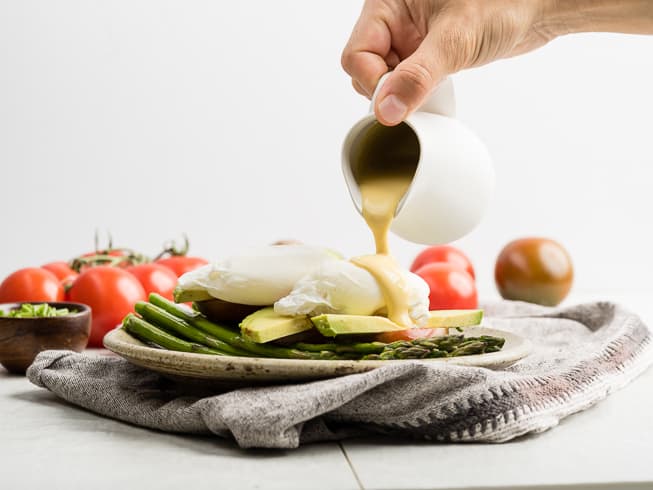
And just like that, you have a super healthy, figure-friendly, low-carb breakfast or brunch. Enjoy!
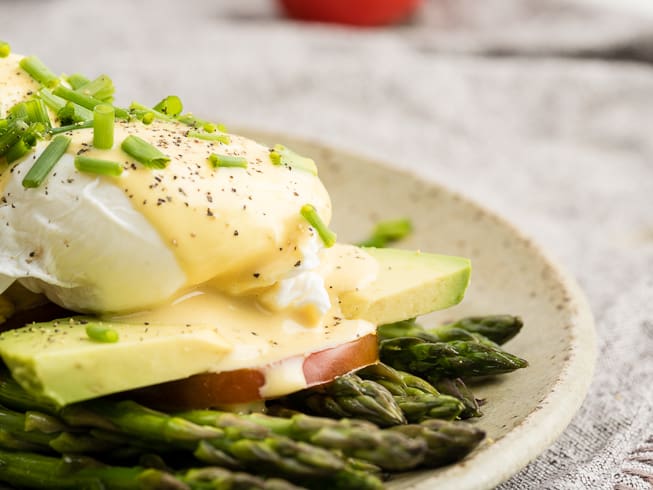
Other Flavorful Egg Dishes
- Shakshuka
- Sausage and Egg Casserole
- Breakfast Salmon Egg Bake
- Veggie Omelet
- Turmeric Eggs
- Breakfast Casserole
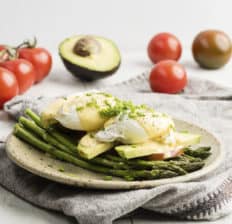
Eggs Benedict Recipe
- Total Time: 27 minutes
- Yield: 2 1x
- Diet: Gluten Free
Description
Eggs Benedict is one the most luxurious breakfast or brunch recipes. Here’s a recipe that ups the nutrients and makes it even more delicious at the same time.
Ingredients
Hollandaise Sauce
- 2 tablespoon grass-fed butter or ghee
- 2 egg yolks
- ¼ teaspoon Dijon mustard
- 1 tablespoon lemon juice
- ¼ teaspoon sea salt
- ½ tablespoon water
Eggs Benedict
- 1 bunch asparagus (16 pieces)
- 1–2 teaspoons coconut or avocado oil
- ¼ large tomato, sliced
- ½ avocado, sliced
- 2 eggs, poached
- chives, chopped
- sourdough or Ezekiel bread, toasted (optional)
Instructions
- For the Hollandaise sauce, in a small sauce pan, melt the butter or ghee over medium-low heat.
- Add all the ingredients into a high-powered blender until well combined.
- In a medium-size frying pan over medium heat, add coconut or avocado oil.
- Add the asparagus to the frying pan and pan fry until for tender, about 8–10 minutes.
- In a small pot, bring 2–3 cups of water to a boil.
- Once boiling, gently lower the eggs into the water and allow to boil for 3 minutes. Remove the eggs once finished and set them aside for assembly.
- Divide the asparagus on two separate plates and add sliced tomato and avocado on top. Optionally, add toasted bread on the plate first.
- Add the eggs and drizzle on the hollandaise.
- Top with chives.
- Prep Time: 15 min
- Cook Time: 12 min
- Category: Breakfasts
- Method: Stovetop
- Cuisine: American
Nutrition
- Serving Size: 1 serving (292g)
- Calories: 362
- Sugar: 3.8g
- Sodium: 377mg (25% DV)
- Fat: 31.2g
- Saturated Fat: 11.8g
- Unsaturated Fat: 17.4g
- Trans Fat: 0.5g
- Carbohydrates: 11.6g
- Fiber: 6.4g
- Protein: 12.4g
- Cholesterol: 379mg
Comments
Please keep comments under 200 characters.





I like to finely slice some brussel sprouts, saute briefly in hot coconut oil. Voila! a perfect bed of greens!
Dr axe thank you for such delicious and healthy recipes. I am enjoying it and loving it. GOD bless you.
I just made this recipe today and it was delicious! The hollandaise sauce was perfect and not runny. One issue with the sauce recipe is that the ingredient list says one egg yolk, but all the pictures show 2 eggs. Don’t know if that would make a difference, but I used one egg yolk and it was fine.
I think it is too runny because of the ratio of fat (ghee) to the egg yolk. If you not adverse to healthy fat, you might want to try melting more ghee and adding it to the yolk, lemon juice, seasonings (sans water). Add hot ghee until the sauce reaches a consistency you like. If you get it too thick by mistake, you could add a bit of water at that point to thin it.
Make the sauce without adding the water or the lemon juice. After the sauce is blended, thin it out by adding half of the lemon juice. If it’s still too thick, add the remaining lemon juice. Then, if it’s still too thick, add just enough water to thin it out. Obviously, the water isn’t used for flavor, and is just added to thin out the sauce, and might not even be needed at all, so just use it as an “add as needed” ingredient.
So many great ingredients in this easy breakfast! I can’t wait to make it tomorrow morning. Thank you for sharing the recipe!